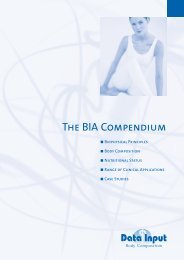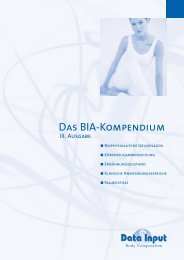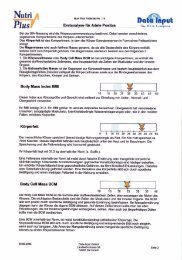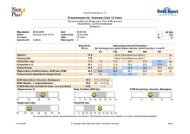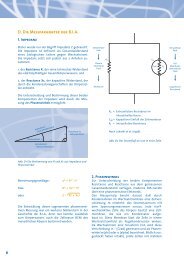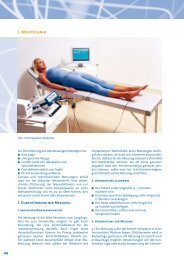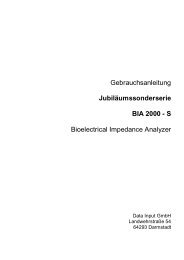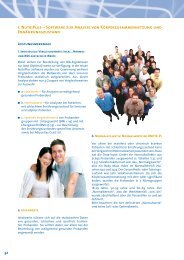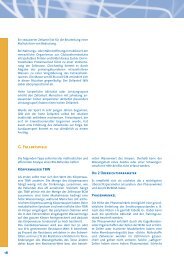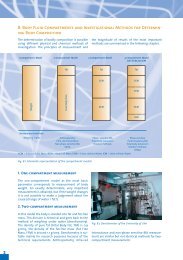Patterns of bioelectrical impedance vector ... - Data-input.de
Patterns of bioelectrical impedance vector ... - Data-input.de
Patterns of bioelectrical impedance vector ... - Data-input.de
Create successful ePaper yourself
Turn your PDF publications into a flip-book with our unique Google optimized e-Paper software.
66 BOSY-WESTPHAL ET AL<br />
FIGURE 3. Mean <strong>impedance</strong> <strong>vector</strong>s with 95% confi<strong>de</strong>nce ellipses from subjects (30 572 men and 183 176 women) stratified by BMI (in kg/m 2 ) and age<br />
groups. Within each graph, the ellipse sequence on the left represents women and that on the right represents men. Within each sex, <strong>vector</strong> down-sloping is<br />
observed with <strong>de</strong>creasing age, ie, the youngest group is represented by the shortest <strong>vector</strong> and the ol<strong>de</strong>st group by the longest <strong>vector</strong>, respectively. H, subjects’<br />
height; R, resistance; Xc, reactance. Graphically nonoverlapping 95% confi<strong>de</strong>nce ellipses are significantly different from each other, P 0.05 (conterminous<br />
with a significant Hotelling’s T 2 test).<br />
therefore be indispensable for a plausible result, ie, an increasing<br />
percentage fat mass with age at the same BMI. By contrast,<br />
age-related changes in body cell mass might be predictable by<br />
conventional BIA by applying prediction equations that inclu<strong>de</strong><br />
Xc (Figure 4C and D). BIA prediction equations need to be<br />
<strong>de</strong>veloped and validated in the population un<strong>de</strong>r study (14, 15).<br />
Some authors suggest that application <strong>of</strong> BIA to el<strong>de</strong>rly populations<br />
requires only uniform validation procedures in the actual<br />
study population but not age-specific equations (16).<br />
Study limitations<br />
The limitations <strong>of</strong> our study <strong>de</strong>rive from the selection criteria<br />
<strong>of</strong> the sample (ie, inquiring rather than examining participants’<br />
health status). Thus, we cannot exclu<strong>de</strong> disturbances in fluid<br />
balance due to mild cardiac or renal insufficiency. However,<br />
because <strong>of</strong> the large sample size, the low variation in results (SD<br />
<strong>of</strong> H 2 /R and H 2 /Xc), and the 95% CI, the effect <strong>of</strong> this bias should<br />
be negligible. Additionally, our study lacks in<strong>de</strong>pen<strong>de</strong>nt data on<br />
body-composition analysis (eg, measuring total body water by<br />
<strong>de</strong>uterium dilution) to confirm that individual <strong>vector</strong> placements<br />
solely <strong>de</strong>termined by electrical properties <strong>of</strong> tissue per human<br />
conductor length relate to body composition in<strong>de</strong>pen<strong>de</strong>ntly <strong>of</strong><br />
body shape and geometry. Future studies will be nee<strong>de</strong>d to examine<br />
this issue. Although we collected a huge database from<br />
centers located in different regions <strong>of</strong> Germany, our data cannot<br />
be consi<strong>de</strong>red to be representative <strong>of</strong> the German population.<br />
Because weight reduction was the main reason for monitoring<br />
nutritional status in the Precon centers, our data on overweight<br />
and obese subjects exceed the average <strong>of</strong> age- and sex-specific<br />
German population references (17). However, the aim <strong>of</strong> our<br />
study was to examine the patterns <strong>of</strong> <strong>bioelectrical</strong> <strong>impedance</strong><br />
<strong>vector</strong> distribution by BMI and age. Thus, we only required a<br />
reasonable number <strong>of</strong> cases in each BMI and age group. The lack<br />
<strong>of</strong> representativeness <strong>of</strong> our study population as a whole is not<br />
contrary to the use <strong>of</strong> our data as a reference for the sex-, age-, and<br />
BMI-<strong>de</strong>pen<strong>de</strong>nt distributions <strong>of</strong> H 2 /R and H 2 /Xc because 1) we




